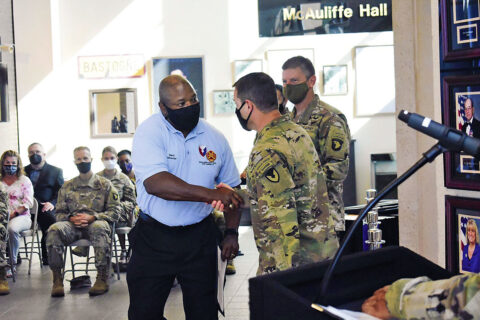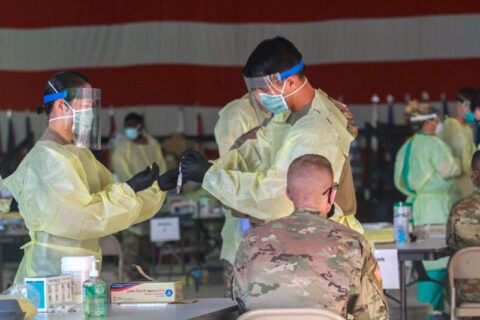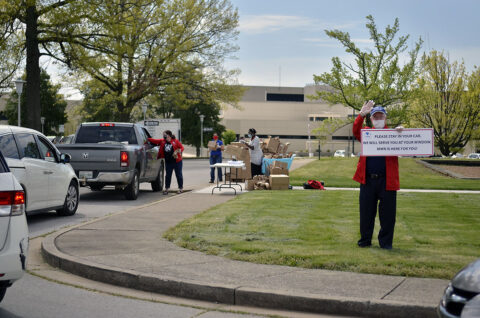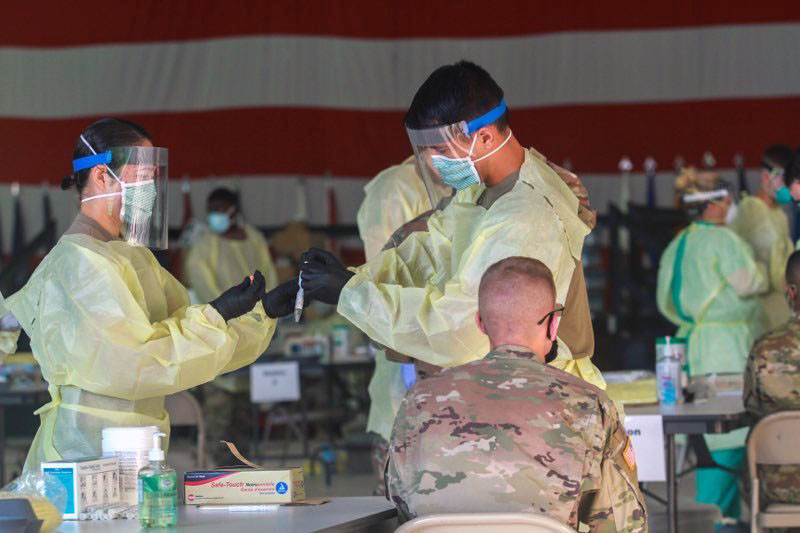 Fort Campbell, KY – Fort Campbell achieved the highest honor among Army garrisons with the presentation of the 2021 Commander in Chief’s Annual Award for Installation Excellence on August 11th, 2021 at 101st Airborne Division (Air Assault) headquarters.
Fort Campbell, KY – Fort Campbell achieved the highest honor among Army garrisons with the presentation of the 2021 Commander in Chief’s Annual Award for Installation Excellence on August 11th, 2021 at 101st Airborne Division (Air Assault) headquarters.
Principal Deputy Assistant Secretary of Defense for Installations Paul D. Cramer, and Deputy Assistant Secretary of Defense for Construction within the Office of the Assistant Secretary of Defense (Sustainment) Michael McAndrew, presented the highly competitive presidential award to Fort Campbell leaders during a virtual ceremony.

The garrison workforce was recognized for exemplary achievements in supporting U.S. Department of Defense missions while also enhancing the working and living conditions for the post’s Soldiers and Families.
Additionally, local mayors and community partners were recognized for their longstanding support and contributions.
“Fort Campbell and the 101st have an unparalleled reputation for being the assignment of choice for Soldiers and their Families,” said Maj. Gen. JP McGee, commanding general of the 101st Airborne Division and Fort Campbell.
“It’s evident in the support the installation provides, our tradition of training excellence, our friendship with the greater community, and in the rich heritage of this place we call home. None of this would be possible without the hard work of our garrison civilians, Soldiers, and contractors who make it happen every day for our Warfighters and their Families. This award is well-deserved and I’m proud to bring it home to Fort Campbell where it belongs.”
The competition judged performance in several areas of installation management including mission support, energy conservation, quality of life, unit morale, environmental stewardship, real property management, safety, health and security, communications, and public relations during fiscal year 2020.
Among Fort Campbell’s major achievements are mounting an early and effective response to the COVID-19 pandemic, deploying thousands of personnel and pieces of equipment to support training operations, innovating best practices to increase the quality of life for Soldiers and Families, starting work on an $87.4 million five-year housing development plan, demolishing nearly 100,000-square-feet of World War II-era wooden structures, consolidating services and strengthening relations with community partners.
“Installation excellence is really based on community partners that are there to deliver because we are no longer islands in the middle of states or in the middle of cities,” Cramer said during the virtual ceremony. “We rely on local communities to deliver services each and every day. Thank you for everything you’ve done for the service members in delivering the services that are needed so that we can maintain a ready force for the United States.”
Safety and Health

Fort Campbell began preparing for COVID-19 Coronavirus before the pandemic reached the U.S., reconfiguring the Public Health Emergency Plan and executing a tabletop exercise to develop an initial response.
As part of that strategy, the installation assembled a COVID-19 Crisis Action Team, or CAT, from members from the division, garrison, and medical commands within 36 hours. The CAT’s early stand-up helped senior leaders make critical decisions and modify essential services to remain open for Soldiers and Families.
“The CAT is a great way to respond to crises across the installation,” said David Clore, chief of plans and operations, Fort Campbell Directorate of Plans, Training, Mobilization, and Security. “It provides a lot of synergy because you have all the right players working together … the impact was huge, and we have daily Microsoft Teams meetings we’re still doing to this day to discuss the amount of people we’ve got infected and the testing numbers. In doing that, we’re able to draw some predictive analysis of what’s coming ahead.”
During FY20, the CAT was responsible for putting together packages of personal protective equipment, cleaning dedicated barracks spaces for quarantine and isolation, ensuring food service locations were following safety measures, and leading the installation’s vaccination effort, among other initiatives.
Those efforts combined with a series of Fort Campbell community Facebook Live town halls to curb infection rates at the pandemic’s peak. The virtual town halls covered topics from COVID-19 prevention to mental health and support services, and Installation Management Command recognized them as a best practice.
The CAT also worked alongside environmental health and safety teams on a multi-month, interagency effort to reopen the installation’s schools. Fort Campbell’s process that included facility inspections, employee training, and rehearsals on contingency plans and reporting procedures, was recognized as a best practice and implemented across Instalaltion Management Command and Department of Defense Education Activity.
In the meantime, Fort Campbell’s Directorate of Family and Morale, Welfare and Recreation worked to keep child care centers open, deliver meals and lift the community’s spirits during the height of the pandemic.
“Child care has always been a mission-essential program, and the Army has long recognized that providing high-quality child care for Soldiers allows them to focus on the mission and not be distracted by worrying about their children,” said Mark Ryales, Child and Youth Services coordinator, MWR. “I think during COVID-19 that message really came into the spotlight, because early on we had to limit services to mission-essential patrons only.”
CYS provided care for approximately 200 children during the pandemic’s early stages, and by May 2020 they had reopened all facilities at 75% capacity.
“We implemented several COVID-19 mitigation strategies to ensure we limited the spread as much as possible in our facilities that were open,” Ryales said. “CYS never shut down, even though we limited the care we provided to certain populations.”
Preventative efforts included limiting building capacity, assigning the same groups of children and staff to specific rooms, hand sanitizing stations; temperature checks, COVID-19 Coronavirus screening questions, limiting the number of children on playgrounds, sanitizing playgrounds after each use, and removing toys that couldn’t be easily sanitized.
“We consolidated our top-selling food items from our establishments and created a Family dining menu,” said Stacye Downing, director, Fort Campbell MWR. “We knew that everyone was really concerned about meals, and the whole in-building service was a challenge at the time for safety and security reasons.”
Downing said adapting that service to COVID-19 Coronavirus was a team effort that drew positive feedback from Soldiers and Families across the installation.
Mission support
Fort Campbell proved to be a foundation of readiness by supporting the 101st Airborne Division (Air Assault), 5th Special Forces Group (Airborne), 160th Special Operations Regiment (Airborne), and other tenant units to deploy more than 20,000 personnel and 8,500 pieces of equipment, including aircraft, to 19 countries in support of six named operations and numerous training operations.
During the COVID-19 Coronavirus pandemic’s onset, the garrison assisted in deploying 286 personnel from the 531st Hospital Command within 72 hours to build a hospital in the Javits Center, where they provided command and control for the DOD’s response to the virus in New York City.
Safely deploying in a COVID-19 Coronavirus environment was a challenge, but Fort Campbell took several steps to ensure units like the 531st remained mission-ready.
“Whenever a unit deploys, they have to be tested,” Clore said. “Everybody had to be tested, and then they had to quarantine. Blanchfield Army Community Hospital was primarily responsible, but the CAT would help coordinate all that, and we did the same thing for the [Joint Readiness Training Center-Fort Polk, Louisiana] rotations.”
By prioritizing resources and services across the installation, instituting virus batch testing, and maximizing support assets, the garrison helped position the 101st Airborne Division (Air Assault) to conduct the Army’s first two JRTC rotations in a COVID-19 environment with a less than 2% positive test rate.
“Not only did we have those two JRTC rotations, we had multiple deployments,” Clore said. “The 101st Combat Aviation Brigade went to Europe, Soldiers from 5th Special Forces Group and other units went to the Middle East on different deployments – even though we were dealing with COVID-19, it didn’t stop us. Our focus all along was maintaining our mission readiness, and we were able to do that.”
Quality of Life

From housing and religious services to recreational programs, quality of life is a top priority for Fort Campbell – and the Spouse Employment Center played a major role in that during 2020.
Fort Campbell’s Spouse Employment Center is an IMCOM-recognized best practice that consolidates the installation’s employment services under one footprint. Among them is the Campbell Strong Workforce Partnership that has provided direct support to Soldiers and Families through a $7.7 million Department of Labor grant.
“With this first-of-its-kind grant, the CSWP complemented and extended the installation’s transition and employment services,” said Anne Fugate, Transition Services Manager. “More than 1,700 transitioning Soldiers and military spouses have enrolled in Campbell Strong and developed a plan to address specific needs or gaps in their career progression.”
As part of those plans, Soldiers and Families received funds to cover expenses including certification and licensing fees, tuition for short-term training, work-related tools and clothing, mileage reimbursement, and child care.
“A total of $4.25 million has been paid in direct participant expenses,” Fugate said. “So far, 1,317 people have completed their plans, with 82% finding employment in health care, information technology, mechatronics, project management, retail, construction, logistics, and other career fields.”
The Spouse Employment Center further addressed employment needs stemming from the COVID-19 pandemic with the Open Air Hiring Fair first hosted in Oct. 2020, an outdoor event that allowed attendees to network safely. For many spouses, it was the first time they were able to attend a hiring event since March 2020.
Fort Campbell’s Directorate of Public Works also began work on an $87.4 million housing development plan that includes 144 new homes in Erevia Park, 170 renovated homes in New Hammond Heights, and the demolition of 250 legacy homes in LaPointe Village.
Fort Campbell worked to receive Army approval for the project, which is the first phase in a larger housing initiative. Lendlease, the Army’s privatized housing partner, negotiated an additional $235 million investment to fund approximately 536 new homes and 495 renovations.
“Fort Campbell’s command team expressed clearly to Lendlease that our No. 1 priority was safe and quality homes,” said Ted Reece, chief, Housing Division, DPW. “The garrison’s role was to communicate effectively our current housing inventory posture, meaning the age of our infrastructure and the need. The fact that many of these homes will be approaching 100 years old at the end of our lease with Campbell Crossing means we needed to get at the renovations much sooner than later.”
Real Property Stewardship
Fort Campbell has been on a mission to demolish the installation’s World War II-era wooden structures for years, and the nearly 100,000-square-feet worth was cleared out in FY20, including the iconic T-39 building.
“Those buildings were originally designed to last 25 years,” said Jessica Stonesifer, director, Fort Campbell Directorate of Public Works. “They have exceeded their design life by far, and what that means for maintenance and energy usage is that you have these facilities with outdated systems. They’re hard and expensive to maintain, and they’re not energy efficient, so we spend a lot of our labor and money on keeping these going.”
Turning off the utilities for a single World War II-era wooden building can save the installation an estimated $2,000 a month, according to Mark Lewis, community planner, DPW Master Planning Division.
For further savings, DPW Roads and Grounds worked with battalions like the 887th Engineer Support Company to demolish 74,000-square-feet of World War II wooden structures at little to no cost.
“Because we were able to do it in-house, we weren’t paying contract costs to do that demolition,” Stonesifer said. “Our Roads and Grounds team loves doing it because it’s training for them. But it’s also training for the engineering battalions because they get to use the equipment for a real-world effort that benefits the installation.”
World War II-era building demolition ties directly into another major priority for the garrison – consolidating services. With limited funding available for new construction, the focus has shifted to optimizing current facilities.
“We’ve been tasked with ensuring that the space we do have is utilized to its maximum extent,” Stonesifer said.
The results of that effort have positively impacted the 101st Airborne Division (Air Assault), Blanchfield Army Community Hospital, Fort Campbell garrison, Army Field Support Battalion-Campbell, and more by moving team members closer together, while also improving the Soldier and Family experience.
“It makes people’s jobs more efficient because they’re near the organizations they work and do business with,” Stonesifer said. “But it also makes it easier on our customers. For instance, if you were a retiree or a spouse and you needed one of the services the Soldier for Life program provides, instead of having to go to three or four locations you can just go to one place.”
Public Relations
Fort Campbell and its neighboring communities have a long-standing symbiotic relationship because of the installation’s strong economic impact on both Tennessee and Kentucky, and that continued into 2020.
That open communication has proven vital in enabling the installation to succeed in a COVID-19 Coronavirus operating environment and played a part in reducing fear and anxiety throughout the community.
“It’s a fitting award for Fort Campbell,” said Clarksville Mayor Joe Pitts after the award presentation. “For those of us who’ve grown up around Fort Campbell, we know it to be the best installation, it’s got great leadership in the garrison as well as the installation. On behalf of the City of Clarksville, I’m grateful for the recognition but it’s really the Family relationship between Soldiers and their Families, the civilian workforce, and the citizens of the city.”
Along with Fort Campbell, the awardees include Naval Support Activity Bahrain, Bahrain; Marine Corps Base Camp Lejeune, North Carolina; Royal Air Force Lakenheath, United Kingdom; and Defense Supply Center Richmond, Virginia.



